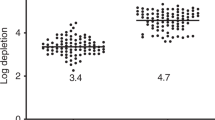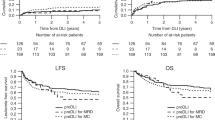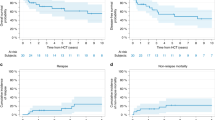Abstract
We evaluated the efficacy and toxicity of different doses of donor T cells given with donor leukocyte infusions (DLI) as treatment for relapse of various hematologic malignancies after allogeneic bone marrow transplantation (BMT). We also studied whether DLI treatment was more effective if circulating T cells were exclusively of donor origin (complete donor T cell chimeras) as compared with T cells originating from both donor and recipient (mixed T cell chimeras). Twenty-eight patients were studied of whom 24 had a complete donor T cell chimerism. The malignancies were as follows: chronic myeloid leukemia (CML) in chronic phase (CP) (n = 9); more advanced CML (n = 5); multiple myeloma (MM) (n = 5); acute leukemia (AL) (n = 9). T cell doses varied from 0.1 × 107 to 33 × 107 T cells/kg. Eight patients received two to four DLI courses because they failed to respond to one course. Thirteen of 14 patients with CML, including four patients with more advanced CML, achieved complete remission (CR). All five patients with MM responded, including three CRs. Six patients (three with CML, three with MM) responded only after two to four DLI courses. Patients with CML-CP were likely to respond to as few as 1 × 107 T cells/kg whereas patients with MM generally responded when they received ⩾10 × 107 T cells/kg. However, despite the infusion of high T cell doses (up to 32 × 107 T cells/kg), practically all patients with AL failed to respond. The likelihood of response was strongly related to the occurrence of graft-versus-host disease (GVHD) in patients with CML and MM (P = 0.0002), although GVHD was not helpful for patients with AL. Higher T cell doses (⩾10 × 107/kg) induced serious GVHD (n = 17) and marrow aplasia (n = 5), and GVHD was directly or indirectly the cause of death for six patients. Finally, there were no obvious differences in responses between complete donor T cell chimeras and mixed T cell chimeras.
This is a preview of subscription content, access via your institution
Access options
Subscribe to this journal
Receive 12 print issues and online access
$259.00 per year
only $21.58 per issue
Buy this article
- Purchase on Springer Link
- Instant access to full article PDF
Prices may be subject to local taxes which are calculated during checkout
Similar content being viewed by others
Author information
Authors and Affiliations
Rights and permissions
About this article
Cite this article
Verdonck, L., Petersen, E., Lokhorst, H. et al. Donor leukocyte infusions for recurrent hematologic malignancies after allogeneic bone marrow transplantation: impact of infused and residual donor T cells. Bone Marrow Transplant 22, 1057–1063 (1998). https://doi.org/10.1038/sj.bmt.1701496
Received:
Accepted:
Published:
Issue Date:
DOI: https://doi.org/10.1038/sj.bmt.1701496
Keywords
This article is cited by
-
G-CSF mobilized vs conventional donor lymphocytes for therapy of relapse or incomplete engraftment after allogeneic hematopoietic transplantation
Bone Marrow Transplantation (2013)
-
Induction of graft versus malignancy effect after unrelated allogeneic PBSCT using donor lymphocyte infusions derived from frozen aliquots of the original graft
Bone Marrow Transplantation (2012)
-
Expression of chimeric antigen receptors in natural killer cells with a regulatory-compliant non-viral method
Cancer Gene Therapy (2010)
-
Donor lymphocyte infusions: the long and winding road: how should it be traveled?
Bone Marrow Transplantation (2008)
-
Chimeric receptors with 4-1BB signaling capacity provoke potent cytotoxicity against acute lymphoblastic leukemia
Leukemia (2004)



